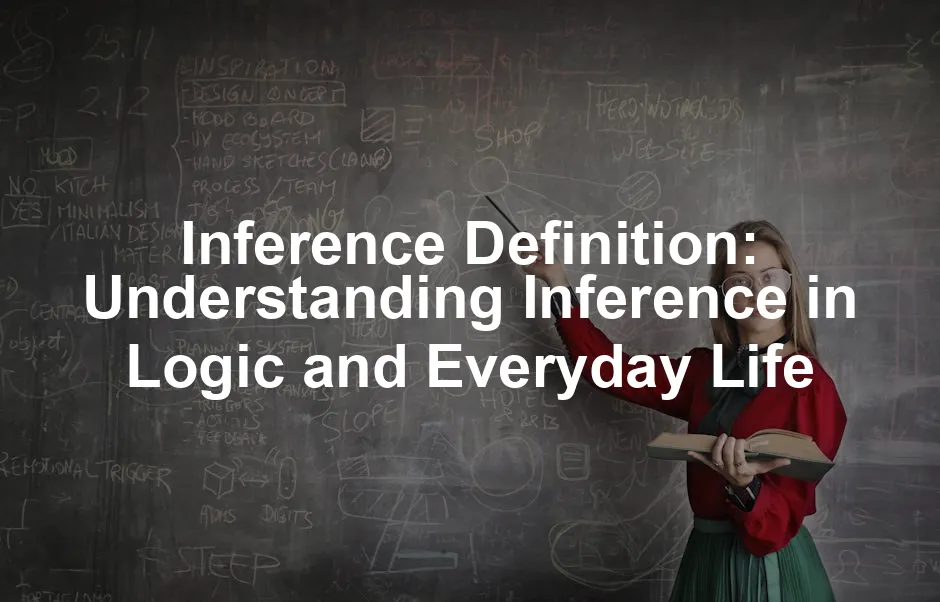Introduction
Inference plays a crucial role in our reasoning and decision-making. It helps us draw conclusions based on evidence and previous knowledge. Whether in conversations or logical arguments, inference shapes our understanding of the world.
Summary and Overview
Inference is the process of drawing conclusions from available information. It involves interpreting evidence to reach logical conclusions. This skill is vital for effective communication and decision-making.
Many people confuse inference with deduction and assumption. Deduction involves deriving specific conclusions from general principles. In contrast, assumptions are beliefs made without evidence.
There are different types of inference: deductive, inductive, and abductive. Deductive inference leads to conclusions that must be true if the premises are. Inductive inference draws generalizations from specific instances, while abductive inference seeks the best explanation.
Inference is important across various fields. In literature, readers infer deeper meanings from texts. In science, researchers use inference to draw conclusions from experimental data. In artificial intelligence, inference allows machines to make decisions based on data inputs.

If you’re looking to sharpen your critical thinking skills, check out Critical Thinking: A Beginner’s Guide by Jennifer Wilson. This book provides practical insights and exercises to help you develop your reasoning abilities and make better decisions.
What is Inference?
Definition of Inference
Inference is both a formal and informal process. Formally, it refers to the logical reasoning from premises to conclusions. Informally, it can be seen as an educated guess based on available evidence.
The term “inference” comes from the Latin “inferre,” meaning “to carry forward.” It signifies the act of moving from known facts to new conclusions.
Related vocabulary includes deduction, conclusion, and reasoning. Each term captures aspects of the inference process, highlighting its importance in logical reasoning.
Understanding inference enhances our critical thinking. It allows us to assess situations more effectively and make informed decisions.

For those who want to dive deeper into the art of inference, consider picking up The Art of Inference: A Guide to Understanding and Interpreting Information. This book provides a comprehensive overview of inference techniques that can enhance your analytical skills.
Types of Inferences
Understanding the different types of inferences helps clarify how we draw conclusions. Here are three primary types:
Deductive Inference
Deductive inference starts with general principles and moves to specific conclusions. If the premises are true, the conclusion must also be true.
Example:
1. All birds have feathers.
2. A sparrow is a bird.
3. Therefore, a sparrow has feathers.
Inductive Inference
Inductive inference works the opposite way. It begins with specific observations and forms broader generalizations. This type of inference is not guaranteed to be true.
Example:
1. The sun has risen in the east every day.
2. Therefore, the sun will rise in the east tomorrow.
Abductive Inference
Abductive inference seeks the best explanation based on available evidence. It often leads to the most plausible conclusions, but these are not certainties.
Example:
1. The grass is wet.
2. It rained last night.
3. Therefore, it likely rained, but there could be other explanations.
These types of inferences play a significant role in reasoning and decision-making, helping us navigate complex situations and form conclusions based on evidence.

Inference in Everyday Life
Making Inferences in Daily Situations
Every day, we make inferences without even realizing it. For instance, if you see someone wearing a raincoat, you might assume it’s raining outside. Similarly, if a friend cancels plans without explanation, you might infer they are feeling unwell. These quick conclusions save time and help us navigate our world.
However, inferences can lead to assumptions, which may not always be correct. For example, if you hear your neighbor arguing, you might assume they are having marital problems. This could lead to misunderstandings and unnecessary gossip. It’s crucial to recognize that not every inference accurately reflects the reality of a situation.

To better understand the nuances of inference, you might find it useful to explore The Inference Game: A Fun Way to Learn About Inferences. This engaging resource turns learning into a playful experience, making it easier to grasp complex concepts.
Inferences in Communication
In conversations, inference plays a vital role. When someone says, “It’s chilly in here,” they might imply that they want you to close a window. As a listener, you infer their intent based on context. This process helps facilitate effective communication.
Yet, this dynamic can create confusion. The speaker’s implication may differ from the listener’s inference. For example, if a manager says, “We need to improve productivity,” an employee might infer they are underperforming. Misunderstandings like this can lead to tension, highlighting the importance of clear communication.

Inference in Literature
The Role of Inference in Reading
When reading, making inferences is essential for understanding deeper meanings. Authors often provide clues, allowing readers to draw conclusions beyond the text. For instance, in To Kill a Mockingbird, readers infer Scout’s growth through her interactions and observations.
Similarly, in The Great Gatsby, the green light symbolizes Gatsby’s unattainable dreams. Readers infer this significance through the context of the story, which adds richness to the narrative.
Good literature encourages readers to think critically, piecing together hints and clues to form a complete picture. This interactive process makes reading engaging and thought-provoking.

If you’re looking to enhance your writing skills, consider The Elements of Style by William Strunk Jr. and E.B. White. This classic guide offers timeless principles for writing well, enhancing your ability to communicate effectively.
Implication vs. Inference
It’s important to distinguish between what an author implies and what a reader infers. An author might suggest a character’s feelings through dialogue, while the reader interprets those feelings based on personal experiences. Understanding this distinction enhances literary analysis and deepens appreciation for the craft of writing.

Inference in Science and Research
Statistical Inference
Statistical inference is a method used in research to draw conclusions from data. It helps researchers make predictions about a population based on a sample. This process often involves two key concepts: hypothesis testing and confidence intervals. For a comprehensive understanding of statistical inference, check out this guide on statistical inference.
Statistical inference is crucial in research for drawing conclusions from data. Learn more about it here.
Hypothesis testing allows researchers to determine if there’s enough evidence to support a specific claim. For example, if a new drug is effective, scientists will test this hypothesis using sample data. They analyze whether the results are statistically significant, meaning they are unlikely to have occurred by chance.
Confidence intervals provide a range of values that estimate a population parameter, such as a mean or proportion. This interval gives researchers an idea of the uncertainty around their estimate. The wider the interval, the less certainty there is about the estimate. Together, these concepts form the backbone of statistical inference, guiding researchers in their decision-making.

For those interested in enhancing their statistical knowledge, Statistics for Dummies by Deborah J. Rumsey is an excellent resource. This book simplifies complex concepts and provides practical examples to help you grasp the essentials of statistics.
Inference in Artificial Intelligence
In artificial intelligence, inference plays a crucial role in how machines make decisions. AI systems utilize inference engines to analyze data and draw conclusions. These engines process information by applying logical rules to the knowledge base they access.
Applications of inference in AI include natural language processing and decision-making systems. For instance, virtual assistants like Siri or Alexa use inference to understand user commands and respond appropriately. By interpreting context and previous interactions, AI can make informed decisions and predictions, enhancing user experience.
To explore the intersection of AI and inference further, consider reading Artificial Intelligence: A Guide to Intelligent Systems by Michael Negnevitsky. This book provides insights into how AI systems operate and the role inference plays in their functionality.
Inference in AI continues to evolve, enabling smarter systems capable of handling complex tasks. As technology advances, the role of inference will remain pivotal in shaping intelligent applications across various fields.

Conclusion
Inference is essential in many areas, including logic, communication, and literature. It allows us to draw conclusions based on evidence and reasoning. Understanding inference enhances critical thinking. It helps you navigate complex situations and make informed decisions. Whether you’re analyzing a text or engaging in conversation, inference plays a key role. By recognizing its significance, you can improve your reasoning skills. Ultimately, mastering inference empowers you to think more clearly and communicate more effectively.

If you’re looking to improve your reasoning skills further, consider exploring Logic: A Very Short Introduction by Graham Priest. This concise overview of logic provides valuable insights into reasoning and inference.
What is the difference between an inference and an assumption?
An inference is a conclusion drawn from evidence and reasoning. It relies on facts to reach a logical conclusion. An assumption, however, is a belief made without proof. While inferences are based on available information, assumptions can be more subjective and may lead to incorrect conclusions.
Can inferences be incorrect?
Yes, inferences can sometimes lead to incorrect conclusions. This happens when the evidence is misinterpreted or insufficient. For example, assuming someone is upset based solely on their silence might not be accurate. Recognizing this potential error is crucial for effective reasoning.
How do we use inference in everyday communication?
Inferences are vital in everyday communication. They help us understand what others imply without stating it directly. For instance, if a friend says, “I’m tired,” we might infer they want to end a conversation. This understanding enhances our interactions and fosters better connections.
What are common examples of inference in literature?
In literature, inference allows readers to uncover deeper meanings. In “The Great Gatsby,” for example, the green light symbolizes Gatsby’s unreachable dreams. Readers infer these meanings through context and narrative clues, enriching their experience of the story.
Why is inference important in scientific research?
Inference is critical in scientific research for drawing conclusions from data. Researchers use statistical inference to generalize findings from samples to larger populations. This process underpins hypothesis testing and helps validate scientific claims.
How can one improve their inference skills?
To enhance inference skills, practice active reading and questioning. Consider the context and implications of statements. Engage in discussions that challenge your reasoning. Additionally, analyze texts critically to identify underlying meanings and assumptions.
What are some examples of logical fallacies related to inference?
Common logical fallacies include hasty generalization, where a conclusion is drawn from insufficient evidence, and post hoc reasoning, which assumes that if one event follows another, the first caused the second. Recognizing these fallacies can improve your reasoning and argumentation skills.
Please let us know what you think about our content by leaving a comment down below!
Thank you for reading till here 🙂
All images from Pexels




